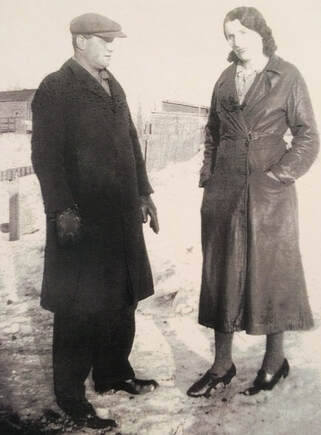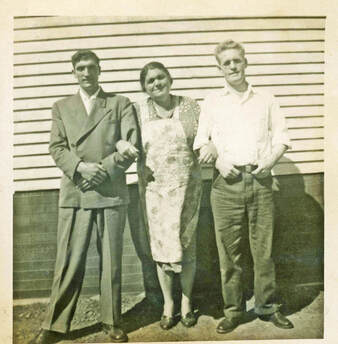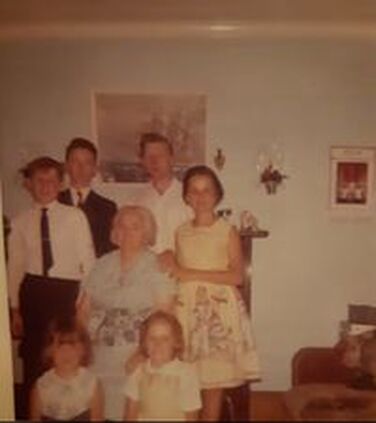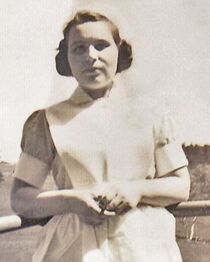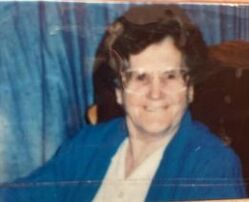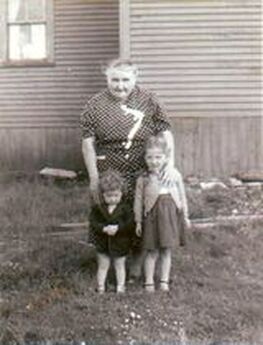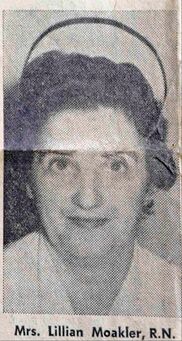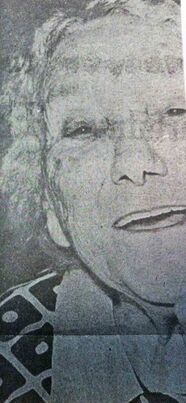HISTORY
HEALTH
HEALTH
MIDWIVES
by Gail Hussey-Weir
Created April 29, 2022 / updated July 2023
by Gail Hussey-Weir
Created April 29, 2022 / updated July 2023
Some of the History of Midwifery in Newfoundland
From the Encyclopedia of Newfoundland and Labrador, V. 3, p. 536:
In Newfoundland and Labrador, lay midwifery, performed by women who rarely had formal training, remained a common practice until the 1920s and beyond. As late as 1923, there were only 40 doctors practicing outside of the Avalon Peninsula, even though the rural population amounted to about 70% of the total population. The midwife was virtually the only provider of maternity care for most women in rural Newfoundland. Indeed, she was often the general community "nurse" as well. Depending in part on the size of the community, there was often more than one midwife.
The typical Newfoundland midwife received no formal instruction in obstetrics and was generally not educated beyond the elementary school level. Training was usually by way of an apprenticeship to an older midwife from whom she received practical training and whatever folk medicine the older midwife knew. Midwifery skills were also passed on from mother to daughter or through self-education. The lay midwife was generally a married woman with a large family. Most did not begin practicing until their children were grown, usually in their mid-forties. Some began practicing out of necessity when their husbands died, midwifery being one of the few types of work available to women, while others did it simply as a community service.
The midwife's work involved not only giving prenatal advice and assisting at birth, but usually postnatal care as well, which often extended to doing the housework of the new mother. Services such as staying with the mother and baby after the delivery, disposing of the bedding upon which the birth had taken place, and daily checks on the mother and baby were also provided. The fee was quite small and was often paid in kind, when at all. Many Newfoundland midwives attended hundreds of healthy births during their careers. Infant mortality and maternal morbidity rates in Newfoundland were nonetheless extremely high.
After World War I, new efforts were made to improve health care in Newfoundland, particularly for mothers and babies, resulting in the establishment of the Midwives Club in 1920 and the formation of the Child Welfare Association in 1921. The Midwives Club developed standards of health care for women who wished to practice midwifery, and weekly classes [in St. John's] were held for three months. The rest of the time the students practiced under the supervision of physicians and nurses. By 1925, 60 women, mostly nurses and practicing lay midwives, had completed training and were practicing within the guidelines of the Midwives Act of 1921, under which a Board was appointed to establish policies.
In Newfoundland and Labrador, lay midwifery, performed by women who rarely had formal training, remained a common practice until the 1920s and beyond. As late as 1923, there were only 40 doctors practicing outside of the Avalon Peninsula, even though the rural population amounted to about 70% of the total population. The midwife was virtually the only provider of maternity care for most women in rural Newfoundland. Indeed, she was often the general community "nurse" as well. Depending in part on the size of the community, there was often more than one midwife.
The typical Newfoundland midwife received no formal instruction in obstetrics and was generally not educated beyond the elementary school level. Training was usually by way of an apprenticeship to an older midwife from whom she received practical training and whatever folk medicine the older midwife knew. Midwifery skills were also passed on from mother to daughter or through self-education. The lay midwife was generally a married woman with a large family. Most did not begin practicing until their children were grown, usually in their mid-forties. Some began practicing out of necessity when their husbands died, midwifery being one of the few types of work available to women, while others did it simply as a community service.
The midwife's work involved not only giving prenatal advice and assisting at birth, but usually postnatal care as well, which often extended to doing the housework of the new mother. Services such as staying with the mother and baby after the delivery, disposing of the bedding upon which the birth had taken place, and daily checks on the mother and baby were also provided. The fee was quite small and was often paid in kind, when at all. Many Newfoundland midwives attended hundreds of healthy births during their careers. Infant mortality and maternal morbidity rates in Newfoundland were nonetheless extremely high.
After World War I, new efforts were made to improve health care in Newfoundland, particularly for mothers and babies, resulting in the establishment of the Midwives Club in 1920 and the formation of the Child Welfare Association in 1921. The Midwives Club developed standards of health care for women who wished to practice midwifery, and weekly classes [in St. John's] were held for three months. The rest of the time the students practiced under the supervision of physicians and nurses. By 1925, 60 women, mostly nurses and practicing lay midwives, had completed training and were practicing within the guidelines of the Midwives Act of 1921, under which a Board was appointed to establish policies.
Some History of Midwifery on Bell Island
Until the hospital opened on Bell Island in 1965, most babies were born at home. As in other Newfoundland outports, the mother-to-be would engage a local midwife to attend the birth, and then to assist with household chores for the next nine days, as it was traditional for the new mother to remain in bed for that length of time. Because of the mining company, we were fortunate to have several doctors at any one time during the mining years. By 1900, there were two mining companies and they each employed a doctor. There were also a number of private practice doctors who worked on the Island over the years.
Unless illness prevented her from doing so, the pregnant housewife continued doing all her usual daily chores right up until she went into labour. When she was ready to deliver, a midwife would attend her, with the doctor only arriving for the actual birth if it was considered necessary. Formal training for midwives became available in the 1920s when the government introduced a 3-month course. Before that, they would learn their trade the traditional way, by learning on the job from another midwife.
Regarding compensation received, Sydney Bown, who administered the Employees' Welfare Plan for DOSCO, said that after 1954, the plan paid $20.00 for a delivery.
Midwife vs. Nurse
While the mining companies each employed a doctor from the beginning of mining operations, there seem to have been few trained nurses until about the 1930s. The first mention I found of a nurse was in February 1914, when it was reported in The Daily News that "a man who had been struck by an ore car in No. 2 Slope was attended by Dr. Cron and Nurse Shepherd." No first name was given, so it is not known if Nurse Shepherd was male or female, and there was no record in the 1913, 1915 or 1919 directories for Bell Island of a Nurse Shepherd. In the 1915 Directory, there is listed a "Miss Kitty Fitzpatrick, nurse, Bell Island East. In the 1919 Directory, Mrs. S. Spencer is listed as a nurse. There are two other nurses listed in the 1919 Directory: Gahaney with the Scotia Company (so working at that company's surgery), and Joliffe with the Dominion Company, but no first name is given for either, so it is not known if they were male or female nurses. In any event, delivering babies does not seem to have been a regular part of the work routine for nurses who worked at the Company Surgery; they were there to assist the Company doctor(s) in the treatment of miners and their family members' ailments.
Nurse Agnes Petrie, in a 1992 interview, stated that when she first graduated (1931), she was not employed immediately by any one doctor, but word quickly got around that she was a nurse and, even though there were quite a few midwives on Bell Island, she was in great demand for assisting in delivering babies. She did not think of herself as a midwife, but doctors would call upon her for assistance when the need arose. In more than one case, she delivered the baby on her own when no doctor was available. When Nurse Hazel Smith retired from the Company Surgery (sometime after 1938), Dr. Templeman asked Agnes to take her place. Once she started working there, she only delivered babies in emergencies.
Nurse Evelyn LeDrew, in a 1995 interview, told of coming to Bell Island in 1940, where she worked mainly as a Public Health Nurse. Along with her other duties, she delivered babies and also helped prepare the dead for burial when called upon to do so.
The Registered Nurses that are included in the list below were mentioned in Facebook comments by people who remembered them as having at one time or another assisted with the birth of babies.
Unless illness prevented her from doing so, the pregnant housewife continued doing all her usual daily chores right up until she went into labour. When she was ready to deliver, a midwife would attend her, with the doctor only arriving for the actual birth if it was considered necessary. Formal training for midwives became available in the 1920s when the government introduced a 3-month course. Before that, they would learn their trade the traditional way, by learning on the job from another midwife.
Regarding compensation received, Sydney Bown, who administered the Employees' Welfare Plan for DOSCO, said that after 1954, the plan paid $20.00 for a delivery.
Midwife vs. Nurse
While the mining companies each employed a doctor from the beginning of mining operations, there seem to have been few trained nurses until about the 1930s. The first mention I found of a nurse was in February 1914, when it was reported in The Daily News that "a man who had been struck by an ore car in No. 2 Slope was attended by Dr. Cron and Nurse Shepherd." No first name was given, so it is not known if Nurse Shepherd was male or female, and there was no record in the 1913, 1915 or 1919 directories for Bell Island of a Nurse Shepherd. In the 1915 Directory, there is listed a "Miss Kitty Fitzpatrick, nurse, Bell Island East. In the 1919 Directory, Mrs. S. Spencer is listed as a nurse. There are two other nurses listed in the 1919 Directory: Gahaney with the Scotia Company (so working at that company's surgery), and Joliffe with the Dominion Company, but no first name is given for either, so it is not known if they were male or female nurses. In any event, delivering babies does not seem to have been a regular part of the work routine for nurses who worked at the Company Surgery; they were there to assist the Company doctor(s) in the treatment of miners and their family members' ailments.
Nurse Agnes Petrie, in a 1992 interview, stated that when she first graduated (1931), she was not employed immediately by any one doctor, but word quickly got around that she was a nurse and, even though there were quite a few midwives on Bell Island, she was in great demand for assisting in delivering babies. She did not think of herself as a midwife, but doctors would call upon her for assistance when the need arose. In more than one case, she delivered the baby on her own when no doctor was available. When Nurse Hazel Smith retired from the Company Surgery (sometime after 1938), Dr. Templeman asked Agnes to take her place. Once she started working there, she only delivered babies in emergencies.
Nurse Evelyn LeDrew, in a 1995 interview, told of coming to Bell Island in 1940, where she worked mainly as a Public Health Nurse. Along with her other duties, she delivered babies and also helped prepare the dead for burial when called upon to do so.
The Registered Nurses that are included in the list below were mentioned in Facebook comments by people who remembered them as having at one time or another assisted with the birth of babies.
Some Known Midwives Working on Bell Island in Mid-20th Century
NOTES:
I created this list from comments to posts on my Facebook Group, Historic Wabana Nfld. In some cases, only a name was mentioned, with no further details (eg. Bennett, Bishop, Day, Lamswood, Spracklin). In some cases, differing details were given about women with the same or similar names, so it is difficult to tell if it is actually one person being described (see, for example, Mary Fitzgerald-Galway, Mary Ellen/Helen Galway, and Mary Galloway). If you can clarify, or if you have anything to add to this list, or see any errors, please get in touch with me through Facebook or by email at [email protected].
The list is alphabetical by surname.
Seeking information for:
Midwife's First name, maiden name, and husband's name.
Midwife's area of operation or neighbourhood (s) served.
Time period in which midwife was delivering babies.
Stories surrounding the birth, including name of doctor who attended.
Fees for service?
I created this list from comments to posts on my Facebook Group, Historic Wabana Nfld. In some cases, only a name was mentioned, with no further details (eg. Bennett, Bishop, Day, Lamswood, Spracklin). In some cases, differing details were given about women with the same or similar names, so it is difficult to tell if it is actually one person being described (see, for example, Mary Fitzgerald-Galway, Mary Ellen/Helen Galway, and Mary Galloway). If you can clarify, or if you have anything to add to this list, or see any errors, please get in touch with me through Facebook or by email at [email protected].
The list is alphabetical by surname.
Seeking information for:
Midwife's First name, maiden name, and husband's name.
Midwife's area of operation or neighbourhood (s) served.
Time period in which midwife was delivering babies.
Stories surrounding the birth, including name of doctor who attended.
Fees for service?
Bennett?
Bishop? Scotia Ridge.
Bishop? Scotia Ridge.
Marie Butler. East End area. She and her family left Bell Island in 1962.
Information from her niece, Dorothy Wilton.
Information from her niece, Dorothy Wilton.
Etta Butt. Scotia No. 1 area. Husband: James.
Information from her granddaughter-in-law, Judy Moores.
Information from her granddaughter-in-law, Judy Moores.
Maria Byrne. Lance Cove area.
Bride Carroll, nee Byrne, of The Green, was a midwife and the daughter of midwife Maria Byrne of Lance Cove.
Information from her daughter, Jean Carroll Fitzgerald.
Information from her daughter, Jean Carroll Fitzgerald.
|
Ethel (nee Simms, 1899-1992) Cobb. She was born February 23, 1899 to Jemima (nee Burton) and Thomas Simms in Triton, NL. She married miner, Hector Cobb, who was killed November 25, 1939, age 41, in an ore car accident in No. 3 Slope. Ethel worked in the Scotia Ridge area and is said to have delivered more than one hundred babies. She died November 14, 1992, age 93. They are buried in St. Boniface Cemetery, Bell Island.
In the photo on the right, she is seen with her husband, Hector Cobb. Photo and information from nephew, Blaine Hussey. |
|
Lillian (nee Jenkins, 1892-1956) Crane. She was born October 5, 1892 to Lavinia (nee Bray) and Henry Jenkins in Harbour Grace, NL. She married Joseph Crane (c.1881-1960) of Upper Island Cove in 1910 in Harbour Grace. They moved to Bell Island, where Joseph was a miner, around 1920. Lillian worked in the West Mines area. She died December 16, 1956 at age 64. Joseph died March 25, 1960. They are buried in St. Boniface Cemetery, Bell Island.
Lillian Crane is pictured on the right with her brother, Harry Crane to her right and her son-in-law, Ted Hussey to her left. Photo courtesy of Joe Crane. |
Day? Scotia Ridge.
Agnes? Fitzgerald
|
Mary (aka Minnie?) Fitzgerald; formerly Mary Galway. [Is this the same woman as Mary Helen (Ellen) Galway below?]
Husbands: 1. David (or John?) Galway; 2. Bernard Fitzgerald. West Mines and Main Street area. She served as a midwife in the mid-20th century. The photo on the right is of Mary Fitzgerald of Fitzgerald's Lane. Photo and information courtesy of Karen (Fitzgerald) Heukshorst. Information also from her granddaughter, Eileen Peers. |
Mary Polly (nee Connors, 1875-1946) Fitzpatrick. Lance Cove Road area. Worked with her daughter, Maggie Hibbs (see below).
Information from her granddaughter, Mary Ellen Connors-Murphy.
Information from her granddaughter, Mary Ellen Connors-Murphy.
Mary Galloway (Is this the same woman as "Mary Galway"?)
Alfreda Galway.
Information from her granddaughter, Jean Noseworthy.
Information from her granddaughter, Jean Noseworthy.
Mary Ellen/Helen Galway. Maiden name: Mercer, daughter of Sarah Anne (nee Galway) and George Mercer.
Husband: John James Galway. Lived No. 4 Range, West Mines. [Is this the same woman as Mary Fitzgerald?]
Information from Judy Whalen Dobbin.
Husband: John James Galway. Lived No. 4 Range, West Mines. [Is this the same woman as Mary Fitzgerald?]
Information from Judy Whalen Dobbin.
Rebecca Gosse, nee Russell. Husband: Josiah Gosse. They lived on Scotia Ridge, where she served as a midwife, about the 1920s.
Information courtesy of her granddaughter, Deborah Kane.
Information courtesy of her granddaughter, Deborah Kane.
Johanna Hammond. Lance Cove.
Margaret (Maggie) Hibbs. Maiden name: Fitzpatrick. [?Daughter of Mary (nee Connors, 1875-1946) and John Francis Fitzpatrick (1871-1935)?]
First husband: William Lane. Second husband: James Hibbs.
Lance Cove Road area.
Time period: 1940s and 50s. Trained by and worked with her mother: Polly Connors Fitzpatrick.
Information from Thomas Fitzpatrick and Mary Ellen Connors-Murphy.
First husband: William Lane. Second husband: James Hibbs.
Lance Cove Road area.
Time period: 1940s and 50s. Trained by and worked with her mother: Polly Connors Fitzpatrick.
Information from Thomas Fitzpatrick and Mary Ellen Connors-Murphy.
Bessie Maud (nee Downton, 1910-2012) Higgins. She was born to Elizabeth and Eli Downton in Glenwood, NL, on June 10, 1910, and grew up in Lewisporte, NL.
Husband: Duncan Higgins.
Town Square area. 1960s (and earlier).
She died March 15, 2012 at age 102, and is buried in the United Church Cemetery, Bell Island.
Information from her granddaughter, Robyn Murphy, and obituary.
Husband: Duncan Higgins.
Town Square area. 1960s (and earlier).
She died March 15, 2012 at age 102, and is buried in the United Church Cemetery, Bell Island.
Information from her granddaughter, Robyn Murphy, and obituary.
Clara (nee Harris) Ivany. She was born February 19, 1905 in Trout River. First husband: Walter Donald Ivany. Second husband: Ernest Ivany. She worked in the West Mines area during the 1930s and 1940s, and often assisted other midwives. She died in Cambridge, ON, in 1998 at age 93.
Information courtesy of Linda Vokey Gennings.
Information courtesy of Linda Vokey Gennings.
Jane (nee Mugford) Jenkins. Husband: Charles Jenkins.
Information from Judith Myers.
Information from Judith Myers.
Anne Kavanagh. RN? East End area.
Agnes (Aggie, nee Fitzgerald?) Kennedy. Lance Cove area. 1940s-50s.
Mary (nee Tubret) Kennedy of Kerry Head, Lance Cove area.
Bridget (Bride) Kent, nee King, was the daughter of Agnes and John King of The Green. Husband: Jack Kent. They lived on Tennis Court Road, off Davidson Avenue. She was a Registered Nurse, who received her training at the Grace General Hospital in St. John's. She worked with Dr. Templeman and Dr. Eagan at the Company Surgery on Town Square, and then at the new hospital on No. 2 Road until her death.
She worked as a midwife in the late 1940s through to 1965 when the new hospital opened. She would tend the new mother and baby for 9 days after the birth, and would take home and wash all the baby's clothes for that period.
Information courtesy of her daughter, Rose Kent and niece, Helen Kent Lucas.
She worked as a midwife in the late 1940s through to 1965 when the new hospital opened. She would tend the new mother and baby for 9 days after the birth, and would take home and wash all the baby's clothes for that period.
Information courtesy of her daughter, Rose Kent and niece, Helen Kent Lucas.
Lamswood?
Margaret Lane-Hibbs: see Margaret (Maggie) Hibbs above.
Margaret Lane-Hibbs: see Margaret (Maggie) Hibbs above.
|
Evelyn LeDrew, nee Roberts, was born November 27, 1913 to Harriet and Walter Roberts of Newtown, B.B. Husband: Lloyd LeDrew. She was a Registered Nurse, who received her training at the General Hospital School of Nursing, graduating in 1939. She worked in several places before being transferred to Bell Island in 1940. She worked mainly as a Public Health Nurse, operating out of her own home until 1968, when she was allocated an office in the Bell Island hospital. Along with her other duties, she delivered babies and also help prepare the dead for burial when called upon to do so. She retired in 1978. You can read more about her long career on Bell Island in the "People" page on this website.
Information is from a personal interview I conducted with her in July 1995. |
|
Annie Lewis, nee Reynolds, was born August 19, 1909 in Riverhead, Harbour Grace. Husband: Alfred (Albert) Lewis. She served as a midwife in The Valley and surrounding areas and beyond. She also worked for the Roman Catholic School Board until retirement in 1979. She died March 5, 1994.
Information and photo courtesy of her daughter and son-in-law, Angela and Gord Johnson. |
|
Mary (aka Maud) McLean (1885-?), nee Mahoney. Husband: John McLean. They lived on Gouthro Street. She worked as a midwife in the West Mines area in the 1920s to 1940s.
Mary's work did not end with the delivery of the baby as she would be involved with helping the new mother for a number of days, including doing all the family's laundry. The photo on the right shows her in the mid-1950s in front of her house on Gouthro Street with her great granddaughters, Debbie French Hickey and Wanda French Dwyer. Information and photo courtesy of her great-great-grand daughter, Susan Boone. |
Isobel Mercer (nee French, 1882-1973). She was born May 13, 1882 to Patience and Abraham Mercer of Bay Roberts. She married William Baggs Mercer in 1902, and the family moved to West Mines, Bell Island, about 1916, where William was a miner and carpenter for DISCO. He died in 1942.
Isobel was a midwife in the West Mines area of Bell Island from about 1916 to about 1945, when she moved to Ontario.
She died in Cambridge on December 5, 1973 and is buried in Mountview Cemetery, Cambridge, ON.
Information from her granddaughter, Barb Murphy, as well as Vital Statistics and Census records, Find-A-Grave website
Isobel was a midwife in the West Mines area of Bell Island from about 1916 to about 1945, when she moved to Ontario.
She died in Cambridge on December 5, 1973 and is buried in Mountview Cemetery, Cambridge, ON.
Information from her granddaughter, Barb Murphy, as well as Vital Statistics and Census records, Find-A-Grave website
|
Lillian (nee Basha, 1923-) Moakler, RN. She was born Bell Island January 21, 1923 to Gertrude (nee Moore, 1887-1945) and Elias Basha (1883-1972), a businessman. She graduated from the General Hospital School of Nursing, St. John's, in 1945. She married businessman Cyril Moakler on October 17, 1951. She worked as a Public Health nurse and became the first Director of Nursing at the new Bell Island Hospital when it opened in 1965. |
Bride Murphy (Is this the same woman as Bridget Pitts below?)
Agnes (nee Bowdring, c.1907-2000) Petrie, RN. She was born Bell Island September 28, c.1907 to Elizabeth (nee Jackman) and Robert Bowdring, a mechanic with Scotia Company. She graduated from the General Hospital School of Nursing, St. John's, in 1931.
When she graduated as a Registered Nurse, she returned to Bell Island to live, but was not employed immediately by any one doctor. Word quickly got around that she was a nurse and, even though there were quite a few midwives on Bell Island, she was in great demand for assisting in delivering babies. She did not think of herself as a midwife, but doctors would call upon her for assistance when the need arose. In more than one case, she delivered the baby on her own when no doctor was available. When Nurse Hazel Smith retired from the Company Surgery (sometime after 1938), Dr. Templeman asked Agnes to take her place. Once she started working there, she only delivered babies in emergencies.
She married Edwin Petrie, a mechanic with DOSCO. Edwin died in 1986. Agnes died February 29, 2000. They are buried in St. Michael's Cemetery, Bell Island.
Information is from a personal interview I conducted with her in October 1992; Census Records; obituary.
When she graduated as a Registered Nurse, she returned to Bell Island to live, but was not employed immediately by any one doctor. Word quickly got around that she was a nurse and, even though there were quite a few midwives on Bell Island, she was in great demand for assisting in delivering babies. She did not think of herself as a midwife, but doctors would call upon her for assistance when the need arose. In more than one case, she delivered the baby on her own when no doctor was available. When Nurse Hazel Smith retired from the Company Surgery (sometime after 1938), Dr. Templeman asked Agnes to take her place. Once she started working there, she only delivered babies in emergencies.
She married Edwin Petrie, a mechanic with DOSCO. Edwin died in 1986. Agnes died February 29, 2000. They are buried in St. Michael's Cemetery, Bell Island.
Information is from a personal interview I conducted with her in October 1992; Census Records; obituary.
Bridget (Bride, nee Murphy) Pitts. 2nd wife of Willard Pitts.
Mary Pumphrey. West Mines/Middleton Avenue area. Husband: Isaac Pumphrey.
Marion (nee Bown) Rees, RN. She was the daughter of Loretto (nee Giovannetti, 1881-1947) and Thomas A. Bown (1872-1940), Resident Manager of Dominion Company on Bell Island from 1907-1914.
Husband: Wallace Rees.
Lance Cove.
Husband: Wallace Rees.
Lance Cove.
|
Alice (nee Kehoe, 1879-1978) Skehans/Skanes. She was born on Bell Island, September 7, 1879 to Mary (nee Quigley, 18?? - c.1881) and James Kehoe, sometimes spelt Keough. Her mother died when she was two; she was raised by an aunt. At age 10, she began working as a housekeeper for her father and two uncles. She eventually worked as a midwife, birthing babies, and as an undertaker, preparing the dead for burial. On September 14, 1907, she married Andrew Skeans, a miner with DISCO, who was from St. John's. Sometime between 1921 and 1935, Alice and Andrew left Bell Island to live on Kenmount Road in the area immediately west of where the main Post Office is today. He was still listed as a miner in 1935, but he was now working at Kelsey's Farm, which was nearby. They later moved to 56 Stamp's Lane, further east, off Kenmount Road.
Alice died September 2, 1978, five days before her 99th birthday. She is buried in Holy Sepulchre Cemetery in Mount Pearl, NL. You can read more about her in the "People" page on this website. |
Spracklin? (Scotia No. 1)
